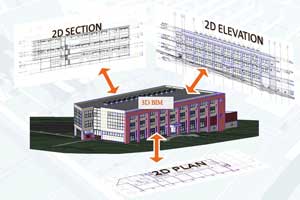dOCTORAL DISSERTATION
"a fRAMEWORK FOR EVALUATING THE BIM COMPETENCY OF BUILDING OWNERS"
Background
 A building information model or BIM may be described as a virtual depiction of the physical and functional aspects of a facility serving as a shared resource of information for different stakeholders throughout its lifecycle (NIBS 2007). Similarly, virtual design and construction (VDC) may be defined as the integrated process of designing and constructing buildings in the virtual world to foresee potential conflicts in the physical world through the application and support of a BIM (Kunz and Fischer 2009). Despite the many perceived benefits of using these processes, several studies have shown that their rate of adoption in the AEC industry still seems to vary greatly among stakeholders and in the different phases of a project's lifecycle. While BIM implementation in the design and construction phases has evolved dramatically in recent years, as an industry we are still a long way from achieving a "mature" life-cycle oriented BIM standard which utilizes the model post construction for facilities management and operations and maintenance.
A building information model or BIM may be described as a virtual depiction of the physical and functional aspects of a facility serving as a shared resource of information for different stakeholders throughout its lifecycle (NIBS 2007). Similarly, virtual design and construction (VDC) may be defined as the integrated process of designing and constructing buildings in the virtual world to foresee potential conflicts in the physical world through the application and support of a BIM (Kunz and Fischer 2009). Despite the many perceived benefits of using these processes, several studies have shown that their rate of adoption in the AEC industry still seems to vary greatly among stakeholders and in the different phases of a project's lifecycle. While BIM implementation in the design and construction phases has evolved dramatically in recent years, as an industry we are still a long way from achieving a "mature" life-cycle oriented BIM standard which utilizes the model post construction for facilities management and operations and maintenance.
Problem
Driven by the knowledge that BIM may result in fewer conflicts and improved coordination, many potential owners are now mandating that BIM be utilized on their new construction projects. However, the change in traditional processes associated with BIM’s utilization is often new to them.As a result:
- They are often unsure of what BIM deliverables and processes to demand for
- They have no way of measuring the technical proficiency of the stakeholders they choose to contract with
Methodology
Therefore, this research aims to assess the BIM competency of building owner organizations and to make suggestions for how to improve their BIM maturity; thereby encouraging the life cycle use of models. The proposed study will combine three research methodologies including: Survey, Delphi Method, and Case Studies. First, using a pilot survey, it will assess the status of BIM implementation among building owner groups and determine their current level of BIM readiness. Then using the Delphi technique, it will determine what key characteristics building owner organizations must possess to become mature BIM users and rate those characteristics based on their perceived importance. Based on this analysis, an evaluation framework will be developed to assess the BIM competency of building owners. Finally, three case studies of facility owner organizations at different BIM competency levels that are requiring BIM will be used to evaluate the proposed framework and examine its usefulness.References
Kunz, J. and Fischer, M. (2009)."Virtual design and construction themes, case studies and implementation suggestions." CIFE Technical reports: http://www.stanford.edu/group/CIFE/online.publications/WP097.pdf (Dec 4, 2010).National Institute of Building Sciences (NIBS). (2007). "National Building Information Modeling Standard - Version 1.0 - Part 1: Overview, principles and Methodologies": National Institute of Building Sciences.
